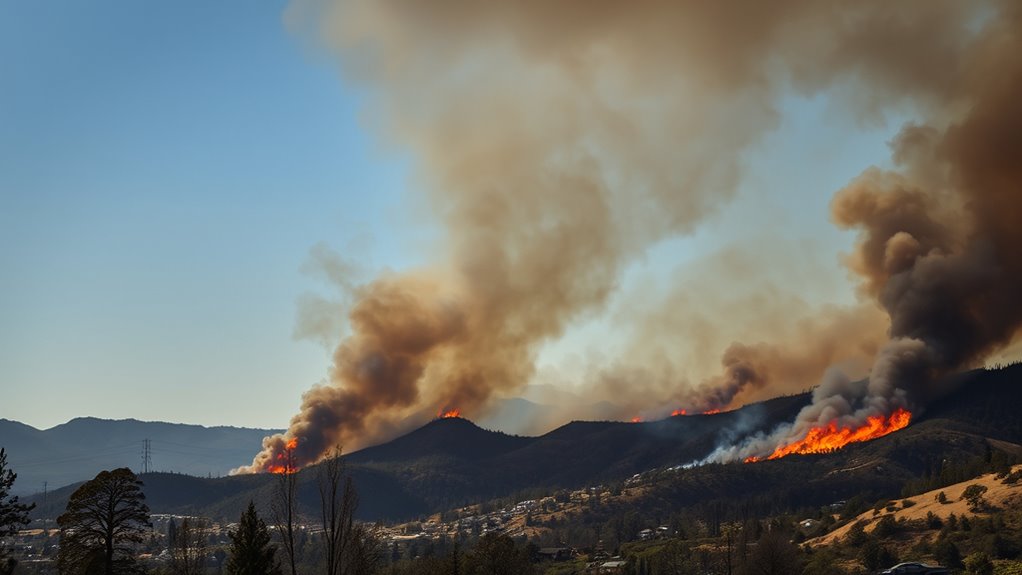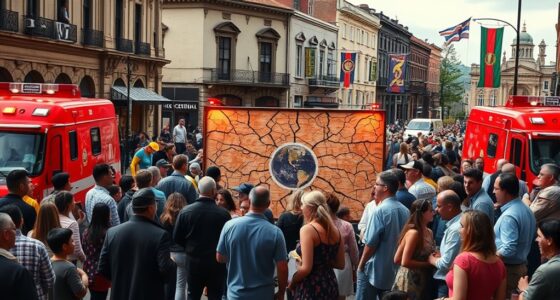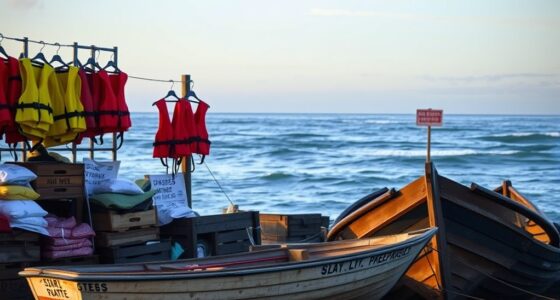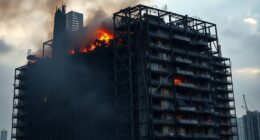The 2018 Camp Fire in California shows how living near wildland areas heightens wildfire risks. Close proximity means homes are surrounded by combustible vegetation, making it easier for fires to spread rapidly. Urban-wildland interfaces require you to maintain defensible space, use fire-resistant materials, and follow safety measures. Knowing how these risks escalate and what precautions to take can help you better prepare and protect your property. Continuing will reveal more about preventing and managing such fires.
Key Takeaways
- The Camp Fire started from PG&E power lines in a region with increasing urban-wildland interface, raising fire risk.
- Proximity of homes to wildland vegetation created a tinderbox environment, facilitating rapid fire spread.
- Building near wildlands without defensible space or fire-resistant materials heightened property vulnerability.
- Lack of clear evacuation routes and preparedness contributed to challenges during the fire’s escalation.
- Community efforts and fire safety regulations aim to reduce ignition sources and improve fire response at the interface.
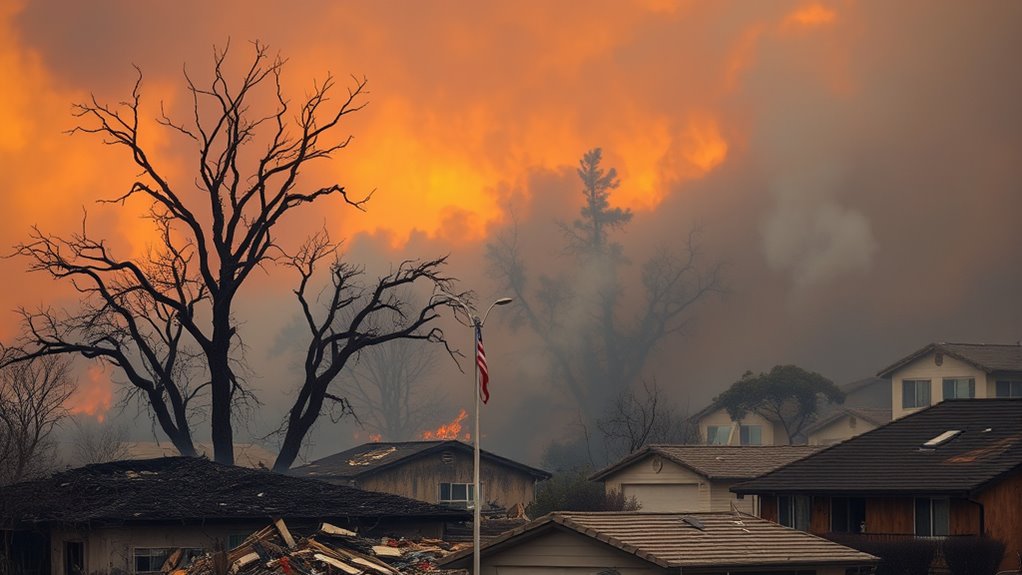
What caused the devastating Camp Fire in California in 2018? It started with a small spark from power lines owned by PG&E, but the real tragedy unfolded because of the region’s increasing urban-wildland interface. As more people build homes close to wildland areas, the risk of fires spreading rapidly escalates. You need to understand that the proximity of homes to combustible vegetation creates a tinderbox, where a single ignition can quickly turn into a massive blaze. This situation underscores the importance of fire safety measures, especially in these vulnerable zones. If you live in such an area, it’s essential to be proactive about fire safety—regularly clearing brush, maintaining defensible space around your property, and using fire-resistant building materials. These steps help prevent ignition and slow the spread of flames, giving you a better chance to protect your home.
Another critical aspect often overlooked is evacuation planning. When fire suddenly erupts, every second counts. You must have a clear evacuation plan in place—know your multiple routes out of your neighborhood and keep emergency supplies ready. The Camp Fire demonstrated how chaos can unfold when residents are unprepared, leading to dangerous delays and dangerous decisions. It’s crucial to stay informed through alerts and weather updates, especially during high fire danger seasons. Practice your evacuation routes regularly so that when the time comes, you can leave quickly and safely without confusion. Keep your vehicle fueled and packed with essentials like water, medications, and important documents, so you’re ready to go at a moment’s notice.
The risk of fires at the urban-wildland interface isn’t just about individual preparedness; it also involves community-wide efforts. Local authorities and fire departments work on creating defensible zones and implementing fire-safe regulations, but your involvement is equally important. Participate in community fire safety programs and stay aware of local fire danger levels. Remember, being prepared isn’t just about reacting after a fire starts, but about preventing ignition and ensuring everyone knows what to do when flames threaten your neighborhood. Recognizing the importance of home theatre projectors and their features might seem unrelated, but understanding how technology can aid in emergency communication, such as displaying alerts or information clearly, can be beneficial in a disaster scenario.
In the end, understanding the causes behind the Camp Fire and taking steps to bolster fire safety and evacuation planning can make all the difference. Fires in these interface zones can spread quickly and have devastating impacts, but with the right knowledge and preparation, you can reduce your risk and protect yourself, your loved ones, and your property. The key is to stay vigilant, plan ahead, and act swiftly when fire danger strikes.
Frequently Asked Questions
How Has Urban Planning Changed Since the Camp Fire?
Since the camp fire, urban planning has shifted to prioritize urban resilience and safety. You’ll notice zoning reforms now restrict building in high-risk wildfire zones, encouraging defensible spaces and fire-resistant materials. Cities are integrating better emergency access and evacuation plans, making communities more prepared. These changes aim to reduce wildfire risks, protect residents, and create more resilient urban-wildland interfaces, ensuring safer living environments for everyone.
What Are the Long-Term Health Effects of Wildfire Smoke?
You may experience long-term health effects from wildfire smoke, including chronic respiratory issues and cardiovascular problems. Prolonged exposure can lead to persistent coughing, wheezing, and increased risk of heart disease. To protect your health, limit outdoor activities during smoke events, use air purifiers, and consult healthcare providers if you notice symptoms. Staying informed and minimizing exposure helps reduce these lasting health impacts.
How Do Fire Prevention Efforts Differ Between Urban and Rural Areas?
Oh, you’d think fire prevention is the same everywhere, right? Not quite. In urban areas, you focus on strict building codes and community outreach to educate residents. Meanwhile, rural areas might rely more on controlled burns and fire breaks. The key difference? Urban efforts aim to protect dense populations, while rural efforts prevent wildfires from spreading unchecked. Both strategies are vital, but they sure do speak different fire prevention languages.
What Role Does Climate Change Play in Increasing Wildfire Risks?
Climate change accelerates wildfire risks through climate feedback and drought intensification. You should know that rising temperatures and shifting precipitation patterns create drier conditions, making forests more susceptible to fires. These changes lead to longer fire seasons and more intense blazes. As climate feedback amplifies warming, your community faces increased danger, requiring stronger prevention and response strategies to adapt to this escalating threat.
Are There New Technologies to Predict and Combat Wildfires Effectively?
You’re in luck—new technologies like satellite monitoring and AI prediction are revolutionizing wildfire management. By using satellites, you can get real-time data on fire spread, while AI models forecast fire behavior with remarkable accuracy. These tools help you detect wildfires early and allocate resources efficiently, ultimately reducing risks. Combining these innovations, you gain a powerful advantage in predicting and combating wildfires before they escalate out of control.
Conclusion
The Camp Fire of 2018 serves as a stark wake-up call, highlighting the fragile dance between urban areas and wildlands. Like a tinderbox waiting for a spark, the risk at the urban-wildland interface grows with each dry season. You must stay vigilant, planning and preparing to prevent another disaster. Only by understanding these risks can we break the cycle and turn the page towards safer, more resilient communities amid California’s fiery landscape.

